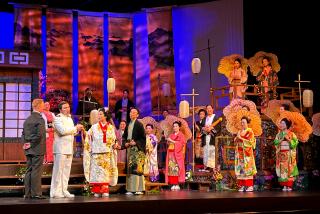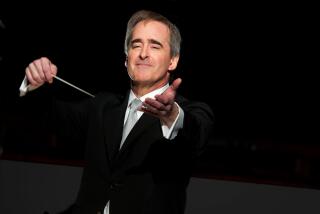48 OF 89 GROUPS SURVEYED IN RED : DEFICITS BURDEN OPERA COMPANIES
- Share via
More opera companies in the United States and Canada are experiencing deficits than ever before, a survey by Opera America reports.
In its “Profile 1986,” Opera America, the service organization for opera organizations in North America, found that among 89 companies, whose budgets range from $65,000 to $75 million, 48--or 54% of them--have been operating in the red. The profile published at the end of last year found 43 companies in deficit.
While the current survey covers the 1984-85 operatic season and the federal fiscal year 1985, which ended Sept. 30, 1985, the profile also points to trends over a five-year period.
On a more positive note, Opera America reports that 50% of the companies in the national organization’s membership were established in the last two decades, “demonstrating the youth and vitality of the art form in North America.”
In particular, the survey cited “the birth of second (opera) companies” in cities “which already had thriving opera companies,” including Chicago, Cleveland and Dallas.
At the same time, Opera America noted that over the five-year federal fiscal period ending Sept. 30, 1985--or roughly comparable to the first-term Reagan Administration budgets--support from the National Endowment for the Arts “failed to keep pace with the needs of the field, increasing only 17%, while opera company expenses have increased 60%.”
During the 1984-85 season, the 89 Opera America companies mounted 328 fully staged productions with orchestra, presented 11 world premieres and four North American premieres. Total operating expenses for the opera field that year reached $235.7 million, while deficits from the 48 companies totaled $7.2 million.
There was also “a dramatic slowdown in the economic growth of the opera field,” the survey found, in terms of both operating budgets and revenues. Total expenses for fiscal year 1985 for a sample group of 50 companies increased 3%, a sharp decline from the previous year’s expense increase of 11%.
Individual contributions continued to be the largest component of unearned income at 16%, the survey reported. This represented a 3% drop from the previous year. Foundations continued in second place as a source of unearned income remaining at 8%.
The survey found that “one of the healthiest developments in the field” was an increase of $2.4 million in corporate giving--or 24% more than corporations gave the year before.
State and local government sources increased to 8% of total income--up from 6% for the previous three years.
Revenues from ticket sales to performances remained the predominant source of income for opera companies, accounting for 40% of total income for fiscal year ‘85, excluding the Metropolitan Opera. At the end of the fiscal year, 11 North American companies had endowments of $500,000 or more--an increase of one company from the year before.
The average price of an orchestra seat, among those companies reporting ticket data was $30. Fifty-five percent of the American companies had tickets available in the $5-$8 range for main-season performances.
In his introduction to the profile, David Gockley, Opera America’s president and general director of Houston Grand Opera, noted: “While there are certainly signs of health and special energy in the field, there are also alarming trends which need to be dealt with, both on the national and local levels.”
As a hopeful sign, he cited “the blurring of definitions among opera, musical theater, the ‘new music’ theater, ‘theater of images’ which have also contributed to creative and programming possibilities which did not seem so accessible a decade ago.
“The evolution of artistic expression into the current ‘post-modern’ era,” Gockley continued, “has brought with it a new eclecticism which cannot but help to increase the chances for successful contemporary forms of expression. . . . “
Meanwhile, Opera America is citing large increases in nonprofit bulk postal rates and the new tax overhaul as “new threats to the financial environment of the arts.”
More to Read
The biggest entertainment stories
Get our big stories about Hollywood, film, television, music, arts, culture and more right in your inbox as soon as they publish.
You may occasionally receive promotional content from the Los Angeles Times.










